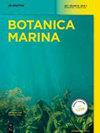Nitzschia venerata, sp. nov., a simulacrum for the conopeate, tube-dwelling diatom Nitzschia martiana, has scuta not conopea: a case of convergent evolution?
IF 1.4
4区 生物学
Q2 MARINE & FRESHWATER BIOLOGY
引用次数: 0
Abstract
Abstract Nitzschia martiana, recently restored to Homoeocladia (C. Agardh) emend Lobban et Ashworth, has needle-like cells and forms macroscopic colonies that are so distinctive that they have been reported on the basis of light microscopy alone. It is the type species for Homoeocladia, which have long flaps (conopea) arising from the sternum and covering a valve depression. This group has extreme diversity at the ultrastructural level and it would not be surprising to find another similar to H. martiana. However, Nitzschia venerata, sp. nov., is a surprising look-alike found in a coral reef seaweed sample from Saipan, Northern Mariana Islands (Western Pacific Ocean). It was studied with light- and scanning electron microscopy. Attempts to find colonies in live and preserved samples were unsuccessful. It is very long and narrow, with a valve depression like that in conopeate species. However, ultrastructurally it is not conopeate because the long flaps arise from the valve face and grow toward the keel and can therefore be classified as scuta. Although tube formation remains unknown, the extreme length and narrowness of the cells suggest it might occur, so that scientists identifying potential H. martiana should be alert to the possibility that they have N. venerata or some other needle-like Homoeocladia.盾形硅藻(Nitzchia venrata,sp.nov.)是锥状体、管栖硅藻马氏盾形体的模拟物,其盾形体不是锥状体:趋同进化的一个例子?
摘要:最近恢复为同源分支(C.Agardh)和Lobban et Ashworth的马氏菱形藻具有针状细胞,并形成肉眼可见的菌落,这些菌落非常独特,仅凭光学显微镜就有报道。它是同始支亚目的模式物种,该亚目有从胸骨伸出并覆盖瓣膜凹陷的长瓣(conopea)。该类群在超微结构水平上具有极端的多样性,发现另一个类似马氏体的类群也就不足为奇了。然而,在北马里亚纳群岛(西太平洋)塞班岛的珊瑚礁海藻样本中发现了一种令人惊讶的长得很像的病毒Nitzchia venrata。用光学显微镜和扫描电子显微镜对其进行了研究。在活体和保存的样本中寻找菌落的尝试没有成功。它很长很窄,有一个像锥状物种一样的瓣膜凹陷。然而,从超微结构上看,它不是锥状的,因为长瓣从瓣面产生并向龙骨生长,因此可以归类为盾片。尽管管的形成尚不清楚,但细胞的极端长度和狭窄程度表明可能会发生这种情况,因此,识别潜在马氏体的科学家应该警惕它们可能患有性病N.venrata或其他针状同源分支。
本文章由计算机程序翻译,如有差异,请以英文原文为准。
求助全文
约1分钟内获得全文
求助全文
来源期刊

Botanica Marina
生物-海洋与淡水生物学
CiteScore
4.10
自引率
4.50%
发文量
43
期刊介绍:
Botanica Marina publishes high-quality contributions from all of the disciplines of marine botany at all levels of biological organisation from subcellular to ecosystem: chemistry and applications, genomics, physiology and ecology, phylogeny and biogeography. Research involving global or interdisciplinary interest is especially welcome. Applied science papers are appreciated, particularly when they illustrate the application of emerging conceptual issues or promote developing technologies. The journal invites state-of-the art reviews dealing with recent developments in marine botany.
 求助内容:
求助内容: 应助结果提醒方式:
应助结果提醒方式:


